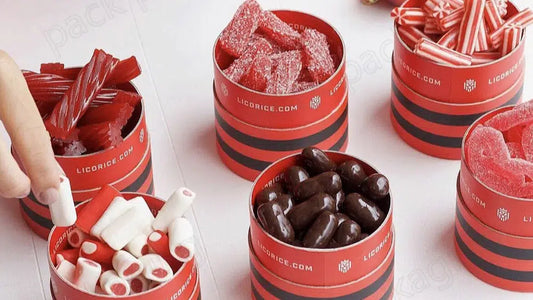The Strategic Impact of Minimalist Packaging
Share
What is Minimalist Packaging
Minimalist packaging is capturing the attention of companies and consumers alike, driven by a global shift towards sustainability and efficiency. This approach to packaging goes beyond aesthetic simplicity, focusing on reducing waste and enhancing the user experience. Throughout this blog, we will explore the various facets of minimalist packaging, discussing why it is not only a design trend but a strategic response to consumer demands for sustainability and functionality.
Minimalist packaging isn't just about using less material. It’s about smart design, prioritizing functionality and the essential elements necessary to protect and present products. By minimizing the use of resources, companies can significantly reduce their environmental footprint, setting a standard in the packaging industry that looks as good as it functions.
The Philosophy of Minimalist Packaging
The core philosophy of minimalist packaging revolves around the idea that simplicity can enhance the product's value. By stripping away non-essential elements, brands can focus on the quality of their products and create a clean, uncluttered presentation that appeals to consumers. This approach not only conserves materials but also challenges designers to be more innovative and thoughtful in their use of space and resources.
Moreover, minimalist packaging aligns with the modern consumer’s preference for transparency and authenticity. Brands that adopt this philosophy are often seen as more trustworthy and responsible. Consumers appreciate the ease of understanding what they are buying, which can enhance brand loyalty and influence purchasing decisions positively.
Environmental Benefits of Minimalist Packaging
Adopting minimalist packaging significantly reduces the environmental impact of a product. By using fewer materials, less waste is generated during the production process, and products become lighter, which also reduces carbon emissions during shipping. These changes contribute directly to a brand’s sustainability goals and appeal to eco-conscious consumers who are increasingly making purchasing decisions based on environmental impact.
The choice of materials in minimalist packaging often includes recycled, recyclable, or biodegradable options. Brands that utilize these materials not only minimize their environmental footprint but also support the circular economy, promoting recycling and reuse of resources. This commitment to sustainability can strengthen a brand’s market position and align it with global efforts to combat environmental degradation.
The Evolution of Minimalist Packaging Design
Minimalist packaging design has evolved from a niche trend to a mainstream approach thanks to technological advancements and changing consumer preferences. Initially focused on reducing visual clutter, modern minimalist packaging now also emphasizes functional simplicity and sustainable choices. Brands are increasingly leveraging advanced materials and innovative designs that maintain, or even enhance, product protection while using less packaging.
The future of minimalist packaging will likely see an increased use of technology such as augmented reality (AR) and smart labels, which allow brands to maintain a minimalist design while providing extensive product information digitally. These technologies offer exciting possibilities for enhancing customer interaction without compromising the minimalist ethos.
The Aesthetic and Functional Appeal of Minimalist Packaging
The aesthetic appeal of minimalist packaging lies in its simplicity, which can make products stand out on crowded shelves. A clean, understated design focuses the consumer’s attention on the product rather than the packaging, fostering a perception of quality and sophistication. This visual appeal is crucial in markets where product differentiation is key to capturing consumer interest.
Functionally, minimalist packaging designs are often more user-friendly. They focus on ease of use—from opening the package to disposing of it. This consideration of the consumer’s entire experience can enhance satisfaction and reinforce brand loyalty. Moreover, simple designs reduce manufacturing complexity, which can lower production costs and decrease the time it takes to bring a product to market.
Take this kind of paper tube packaging for example, it demonstrates the aesthetic appeal of minimalist packaging with its clean and sophisticated design. Functionally, these packaging solutions are designed to be user-friendly, focusing on ease of use—from opening the package to disposing of it. Such designs not only reduce manufacturing complexity and lower production costs but also decrease the time it takes to bring a product to market.
Consumer Perception and Market Impact
Consumers today are more aware of the environmental and social impacts of their purchases than ever before. Minimalist packaging, with its reduced environmental impact and efficient use of materials, resonates with these values, attracting a broad demographic of sustainability-conscious buyers. This shift in consumer preferences is influencing companies across industries to reconsider their packaging strategies to align with these expectations.
The market impact of minimalist packaging extends beyond consumer perception. It can significantly enhance a brand's reputation and competitive edge. As consumers increasingly prefer brands that demonstrate environmental responsibility, minimalist packaging can be a powerful tool to attract and retain customers, ultimately affecting a company’s bottom line.
Challenges and Considerations in Adopting Minimalist Packaging
Transitioning to minimalist packaging presents several challenges. One of the primary considerations is ensuring that reducing packaging materials does not compromise product protection. Companies must carefully balance the need for minimalism with the functional requirement to keep products safe during transport and storage. This often requires innovative thinking and could entail initial higher costs due to research and development of new packaging solutions.
Another consideration is regulatory compliance. Packaging laws and regulations vary widely by region and product type, requiring companies to ensure that their minimalist designs still meet all legal standards for safety, labeling, and materials. Navigating these regulations can be complex, particularly for companies operating in multiple markets.
The Minimalist Packaging Journey
As we conclude, it's clear that minimalist packaging is much more than a design trend; it is a strategic response to the evolving needs of both the market and the environment. It embodies the principles of sustainability and consumer-centered design, making it a crucial aspect of modern product marketing and branding. As environmental concerns become more pressing, the appeal of minimalist packaging is likely to grow, offering brands an opportunity to lead with innovation and responsibility.
Moreover, minimalist packaging aligns with the increasing consumer demand for authenticity and simplicity in product presentation. This alignment not only meets market trends but also builds a foundation for deeper customer relationships and loyalty. Companies looking to adopt minimalist packaging must consider both the aesthetic and functional aspects of their designs to fully leverage the benefits of this approach.
In summary, the journey towards minimalist packaging is both a challenge and an opportunity for brands. It requires a thoughtful consideration of design, materials, and consumer interaction, but offers significant rewards in terms of brand differentiation, environmental impact, and customer engagement. As we move forward, embracing minimalism in packaging could well be a defining trend in the sustainable practices of the future, reshaping how companies approach product presentation in an eco-conscious world.
Should you have any questions about minimalist packaging, please message below. We are always here to help. Alternatively, you can visit our website at Esytube.com to explore more about it.




